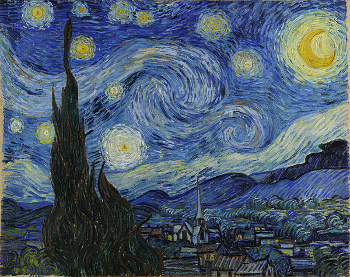
Van Gogh's Fading Reds
April 9, 2015 Children are subject to many small disappointments throughout their childhood. In my youth, we lived in an older house, since demolished, that had interior door locks opened by huge keys. I was gifted with one of those keys at about age six, and I was heartbroken when it was lost. One smaller disappointment was finding my small, red, plastic airplane bleached to pink after exposure to the Sun's rays after wintering on a porch. Later, I learned about the mechanism of photochemical bleaching of organic dyes. | Red plastic airplane. Photochemical bleaching is the reason why museums don't allow flash photography. (Photo by Gwafton, via Wikimedia Commons.) |
 | Vincent van Gogh (1853-1890), "The Starry Night" (1889, Oil on canvas). (Museum of Modern Art, Accession number 472.1941, via Wikimedia Commons.) |
 |
| Left, Wheat sheaves in a field, August, 1885; right, Landscape with wheat sheaves and rising moon, July, 1889; both from the Kröller-Müller Museum, via Wikimedia Commons. |
"Normally, the idea is these paintings are there for a hundred years, or five hundred years, and they're static – nothing really changes... but the opposite is actually true when you look in detail."[5]The Antwerp team examined a minute white particle from the pond area in the painting, and they used X-ray powder diffraction mapping and tomography to determine the chemical phases present. The equipment, at the DESY synchrotron light source, PETRA III, allowed a depth profiling of the specimen.[4-5] What they discovered was an extremely rare lead mineral, plumbonacrite, 3PbCO3·Pb(OH)2·PbO), which is the first report of this chemical compound in a painting created prior to the mid-20th century.[3]
 | Vincent van Gogh (1853-1890), Wheat stack under a cloudy sky (Korenschelf onder wolkenlucht), oil on canvas, October 1889. (© Collection of the Kröller-Müller Museum, Otterlo, The Netherlands and used with permission.) |
References:
- Letizia Monico, Geert Van der Snick, Koen Janssens, Wout De Nolf, Costanza Miliani, Johan Verbeeck, He Tian, Haiyan Tan, Joris Dik, Marie Radepont and Marine Cotte, "Degradation Process of Lead Chromate in Paintings by Vincent van Gogh Studied by Means of Synchrotron X-ray Spectromicroscopy and Related Methods. 1. Artificially Aged Model Samples," Anal. Chem., vol. 83, no. 4 (February 14, 2011), pp, 1214-1223.
- Letizia Monico, Geert Van der Snick, Koen Janssens, Wout De Nolf, Costanza Miliani, Joris Dik, Marie Radepont, Ella Hendriks, Muriel Geldof and Marine Cotte, "Degradation Process of Lead Chromate in Paintings by Vincent van Gogh Studied by Means of Synchrotron X-ray Spectromicroscopy and Related Methods. 2. Original Paint Layer Samples," Anal. Chem., vol. 83, no. 4 (February 14, 2011), pp, 1224-1231.
- Frederik Vanmeert, Geert Van der Snickt, and Koen Janssens, "Plumbonacrite Identified by X-ray Powder Diffraction Tomography as a Missing Link during Degradation of Red Lead in a Van Gogh Painting," Angew. Chem., vol. 127, no. 12 (March 16, 2015), pp. 3678-3681, doi: 10.1002/ange.201411691.
- Fading Orange-Red in Van Gogh's paintings, Deutsches Elektronen-Synchrotron Press Release, March 10, 2015.
- Matthew Gunther, "Shedding light on fading reds in Van Gogh's paintings," Chemistry World, March 3, 2015.
- Letizia Monico, Geert Van der Snick, Koen Janssens, Wout De Nolf, Costanza Miliani, Joris Dik, Marie Radepont, Ella Hendriks, Muriel Geldof and Marine Cotte, "Degradation Process of Lead Chromate in Paintings by Vincent van Gogh Studied by Means of Synchrotron X-ray Spectromicroscopy and Related Methods. 2. Original Paint Layer Samples," Anal. Chem., vol. 83, no. 4 (February 14, 2011), pp, 1224-1231.